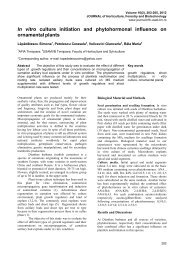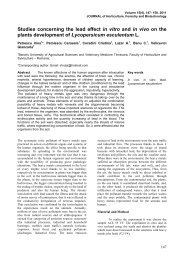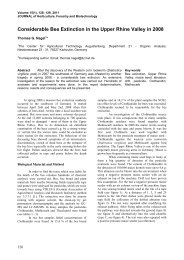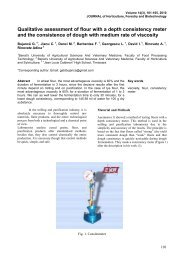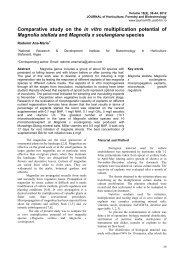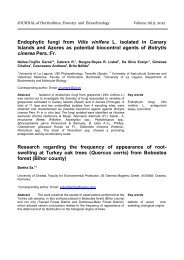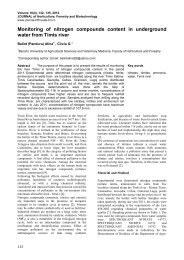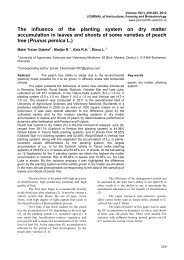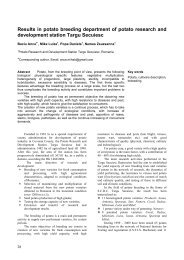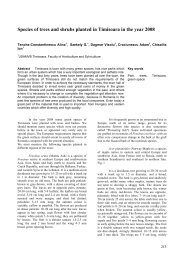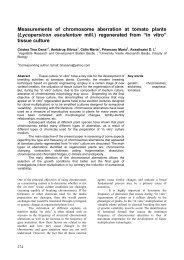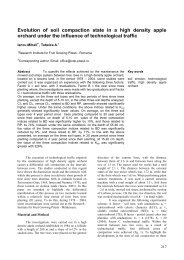Parasitoids of Ips typographus (Coleoptera: Scolytidae) - Journal of ...
Parasitoids of Ips typographus (Coleoptera: Scolytidae) - Journal of ...
Parasitoids of Ips typographus (Coleoptera: Scolytidae) - Journal of ...
You also want an ePaper? Increase the reach of your titles
YUMPU automatically turns print PDFs into web optimized ePapers that Google loves.
Table 1<br />
Characteristics <strong>of</strong> the plots in the Natural Park Apuseni<br />
Location<br />
Arboretum<br />
composition<br />
Average<br />
age<br />
Consistency Litter Altitude Array Declivity Tree<br />
no.<br />
Sample<br />
no.<br />
Poiana Ponor 10MO 100 0.7 4 1160 SV 21 2 8<br />
Valea Someşului<br />
Cald<br />
10MO 120 0.7 3 1175 S 20 2 8<br />
Cheile Ordâncuşii 6MO 4FA 70 0.8 3 868 SE 36 2 8<br />
Sampling method<br />
The sampling trees were chosen from those<br />
infested, and the sampling took place in two takes. The<br />
total tree number and the samples taken are presented<br />
in table 1. The first take <strong>of</strong> peaks and branches was<br />
sampled after flight I (10 June) and the second take<br />
after flight II (27 July). From each tree 4 samples were<br />
taken, thin parts <strong>of</strong> the crown (peaks and branches)<br />
infested by bugs. Each sample measured 1m in length<br />
6-12 cm in diameter, since it is a well know fact that<br />
Pityogenes chalcographus predominanatly attacks<br />
bodies less than 15 cm in diameter (Stolina, 1969).<br />
Thus, in take I 12 infested assays were gathered and in<br />
take II other 12 assays. The samples thus constituted<br />
were numbered, introduced in collectors and set in<br />
three locations near the sampling areas (Padiş, Doda<br />
Pilii, Casa de Piatră).<br />
Collectors<br />
The collectors (figura 1) are made from PE type<br />
transparent pipes, with 30 cm in diameter and 1 m in<br />
length, placed vertically. At their inferior end the<br />
collectors have a broad cone which at its base unloads<br />
in an insect collecting recipient.<br />
172<br />
Fig. 1. Collectors for insects (Natural Park<br />
Apuseni/Padiş)<br />
On their superior side, the collectors have a cloth<br />
which allows inside ventilation but does not allow the<br />
insects to exit. Once in 7 days the insects are collected<br />
in plastic recipients, they are numbered and dated. The<br />
last verifications were carried out in 19.09.<br />
Species identification<br />
The samples were analysed in the Forest<br />
Entomology laboratory <strong>of</strong> the Faculty for Horticulture<br />
and Forestry <strong>of</strong> Timişoara, from the point <strong>of</strong> view <strong>of</strong><br />
the species composition as well as from a quantitative<br />
point <strong>of</strong> view.<br />
Results and Discussions<br />
During the 3 months observation period, 8 main<br />
predator species for the Pityogenes chalcographus<br />
beetle could be identified (figura 2), as follows:<br />
Nemosoma elongatum (<strong>Coleoptera</strong>: Trogositidae),<br />
Rhizophagus cribratus (<strong>Coleoptera</strong>: Monotomidae),<br />
Rhizophagus depressus (<strong>Coleoptera</strong>: Monotomidae),<br />
Thanasimus formicarius (<strong>Coleoptera</strong>: Cleridae),<br />
Quedius plagiatus (<strong>Coleoptera</strong>: Staphylinidae),<br />
Quedius lateralis (<strong>Coleoptera</strong>: Staphylinidae), Quedius<br />
cruentus (<strong>Coleoptera</strong>: Staphylinidae), Quedius<br />
xanthopus (<strong>Coleoptera</strong>: Staphylinidae).<br />
The first three species represented 90.74% (figure<br />
2) <strong>of</strong> the total captured predator number: Nemosoma<br />
elongatum, Rhizophagus cribratus şi Rhizophagus<br />
depressus. Less represented were the species<br />
Thanasimus formicarius, Quedius plagiatus, Quedius<br />
lateralis, Quedius cruentus and Quedius xanthopus. On<br />
all three locations Nemosoma elongatum was the<br />
dominant species <strong>of</strong> main importance. Not the same<br />
can be said about the other 7 species which, together,<br />
represented less than 24% <strong>of</strong> the total captures. The<br />
Nemosoma elongatum species was encountered in<br />
every wood sample from the collectors <strong>of</strong> both take I<br />
and II, thus accounting for the greatest frequency. Next<br />
in line was the predator Rhizophagus cribratus which<br />
represented 25% <strong>of</strong> the take I samples and 67% <strong>of</strong> the<br />
take II samples. Rhizophagus depressus was present in<br />
42% <strong>of</strong> the take I samples and in 50% <strong>of</strong> the take II<br />
samples. Thanasimus formicarius came up in 25% <strong>of</strong><br />
the take I samples and in 25% <strong>of</strong> the take II samples.<br />
Quedius plagiatus was present in 20% <strong>of</strong> the take I<br />
samples and in 20% <strong>of</strong> the take II samples. Quedius<br />
cruentus came up in 17% <strong>of</strong> the take I samples and in<br />
20% <strong>of</strong> the take II samples. Quedius lateralis and<br />
Quedius xanthopus were in 8% <strong>of</strong> the take I samples<br />
and in 17% <strong>of</strong> the take II samples.



